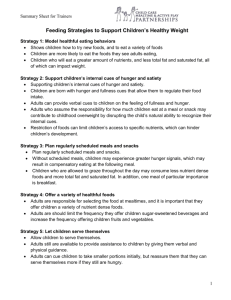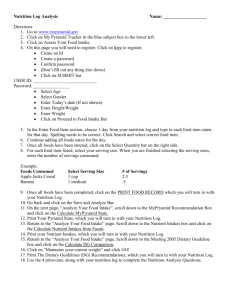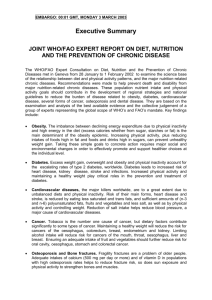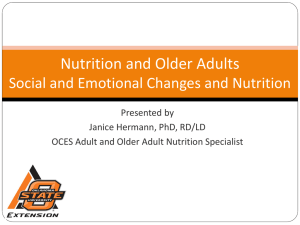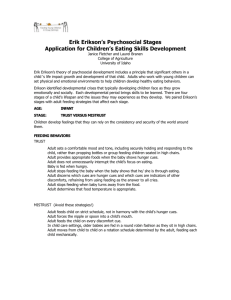Workshop Handout - Child Care MAPP
advertisement
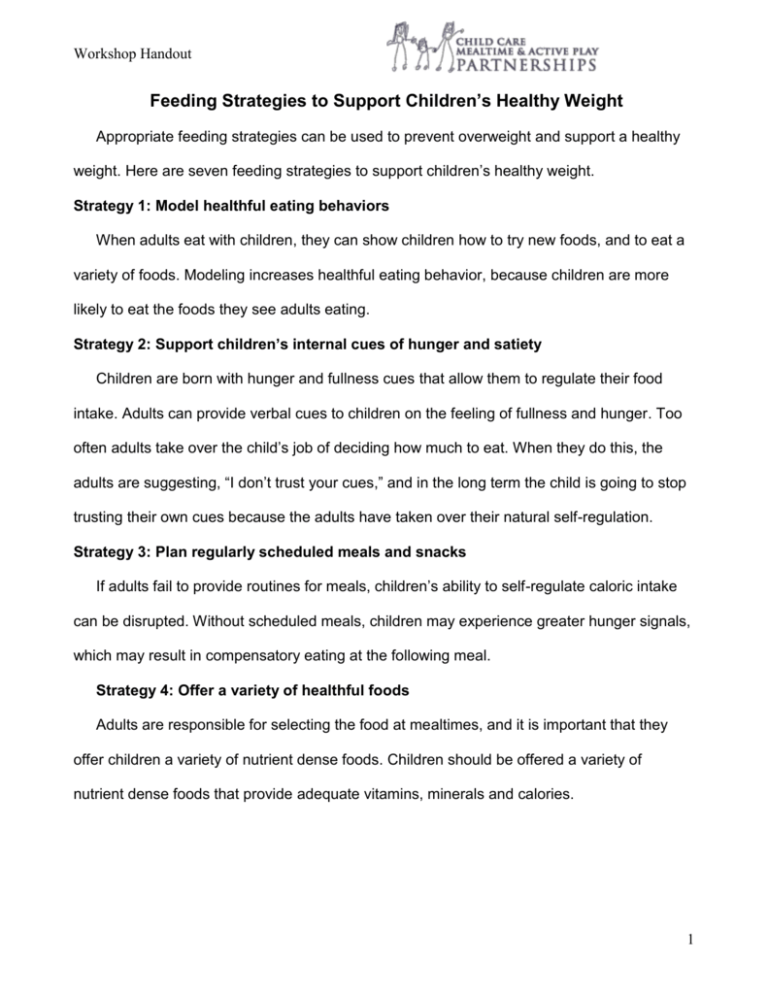
Workshop Handout Feeding Strategies to Support Children’s Healthy Weight Appropriate feeding strategies can be used to prevent overweight and support a healthy weight. Here are seven feeding strategies to support children’s healthy weight. Strategy 1: Model healthful eating behaviors When adults eat with children, they can show children how to try new foods, and to eat a variety of foods. Modeling increases healthful eating behavior, because children are more likely to eat the foods they see adults eating. Strategy 2: Support children’s internal cues of hunger and satiety Children are born with hunger and fullness cues that allow them to regulate their food intake. Adults can provide verbal cues to children on the feeling of fullness and hunger. Too often adults take over the child’s job of deciding how much to eat. When they do this, the adults are suggesting, “I don’t trust your cues,” and in the long term the child is going to stop trusting their own cues because the adults have taken over their natural self-regulation. Strategy 3: Plan regularly scheduled meals and snacks If adults fail to provide routines for meals, children’s ability to self-regulate caloric intake can be disrupted. Without scheduled meals, children may experience greater hunger signals, which may result in compensatory eating at the following meal. Strategy 4: Offer a variety of healthful foods Adults are responsible for selecting the food at mealtimes, and it is important that they offer children a variety of nutrient dense foods. Children should be offered a variety of nutrient dense foods that provide adequate vitamins, minerals and calories. 1 Workshop Handout Strategy 5: Let children serve themselves Letting children serve themselves can help children self regulate their food intake. Adults still are available to provide assistance to children by giving them verbal and physical guidance. Adults can cue children to take smaller portions initially, but reassure them that they can serve themselves more if they still are hungry. Strategy 6: Supportive Environment A pleasant mealtime environment fosters children’s ability to self-regulate intake, encourages a variety of foods, and promotes communication and interaction between children and the adults. The way to ensure the mealtime environment is pleasant is accomplished by establishing a positive physical, auditory, and social environment that is comfortable, safe and with no TV. Strategy 7: Avoid rewarding or consoling with food When adults consistently reward and console children with food, they are creating a food habit that may last the child’s lifetime. Rewarding with food elevates the preference for that food. Further, rewarding and consoling with food along with other manipulative feeding strategies to persuade children to eat more, eat less, or to behave in a specific way, hinders children’s ability to self regulate intake of food. The seven feeding strategies are guiding strategies for mealtimes with young children in group settings that can provide an optimize mealtime environments to be supportive of children’s healthy weight. Moag-Stahlberg, A., Miles, A., & Marcello, M. (2003). What kids say they do and what parents think kids are doing. Journal of the American Dietetic Association, 11, 1541-1546. Satter, E. (1987). How to get your kid to eat but not too much. Boulder, CO: Bull Publishing Company. Johnson, S. L. (2000). Improving preschoolers’ self-regulation of energy intake. Pediatrics, 106, 1429-1435. Sigman-Grant, M., Christiansen, E., Fernandez, G., Fletcher, J., Johnson, S.L., Branen, L.J., & Price, B. (2008). Hungry Mondays: Low-income children in child care. Hunger & Environmental Nutrition, 2, 19-38. Fisher, J.O., Liu, Y., Birch, L.L., & Rolls, B.J. (2007). Effects of portion size and energy density on young children’s intake at a meal. American Journal of Clinical Nutrition, 86, 174-179. Fisher, J.O. & Birch, L.L (1999). Restricting access to palatable foods affects children's behavioral response, food selection, and intake. American Journal of Clinical Nutrition, 69,1264–1272. Dennison, B.A., Erb, T.A., & Jenkins, P.L. (2002). Television viewing and television in bedroom associated with overweight risk among low-income preschool children. Pediatrics, 109, 1028 – 1035. Weight Relativities Division of the Society for Nutrition Education. (2003). Guidelines for childhood obesity prevention programs: Promoting healthy weight in children. Journal of the Nutrition Education and Behavior, 35, January-February. Barlow, S.E., & Dietz, W. H. (1998). Obesity evaluation and treatment: Expert committee recommendations. Pediatrics, 102, 1-11. Wardle, J., Carnell, S., Haworth, C. M. A, & Plomin, R. (2008). Evidence for a strong genetic influence on childhood adiposity despite the force of the obesogenic environment. American Journal of Clinical Nutrition, 87, 398404. Rampersaud, G. C., Pereira, M. A., Girard, B. L., Adams, J., & Metzl, J. D. (2005). Breakfast habits, nutritional status, body weight, and academic performance in children and adolescents. Journal of the American Dietetic Association, 105, 743-760. 2
